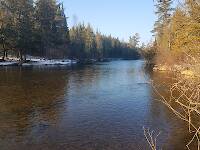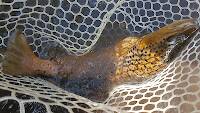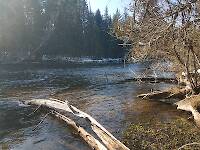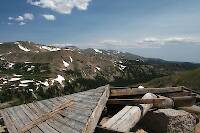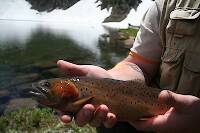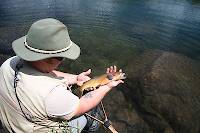
Salmonflies
Pteronarcys californica
The giant Salmonflies of the Western mountains are legendary for their proclivity to elicit consistent dry-fly action and ferocious strikes.
Featured on the forum

Troutnut is a project started in 2003 by salmonid ecologist Jason "Troutnut" Neuswanger to help anglers and
fly tyers unabashedly embrace the entomological side of the sport. Learn more about Troutnut or
support the project for an enhanced experience here.
Martinlf on Feb 20, 2007February 20th, 2007, 2:07 am EST
After slandering Hafele's DVD in a vain attempt to deny Taxon that Latin pronunciation point, I've had many a sleepless night. The hypocrisy of denigrating someone who has made a worthy contribution to our sport, just to pick on Roger, weighs heavily on my conscience, so here are a few admissions.
Hafele's book, Nymph Fishing Rivers & Streams is a beautiful book, full of interesting information. Although I've decided to not keep insect samples very often (the catch and release ethic has even found its way into my attitude towards bugs), he has excellent suggestions for those who want to preserve samples, and some good ideas for collecting them.
But even more interesting to me are his descriptions of the many different nymphing methods. Below I'll post my sketchy and inadequate outline of some of the methods he much more thoroughly describes in hopes that my fellow anglers will correct my mistakes, describe other methods, comment on their use of any of these methods, or be motivated to study further the methods as described in Hafele's book. Oh, the DVD is silly, but in the good Gary Lafontaine way, and it has some nice footage. (This by the way still does not mean I agree with the way he pronounces baetis, Calli- or not.)
METHODS:
Brooks method. Heavy flows, heavy flies. Sinking line.
Shot and indicator. Various flows, fly on or near the bottom.
Hinged leader. Slower flows, fly directly below indicator.
High stick. Various flows, fly on or near bottom. Short line. Stay in touch with fly or weight.
Czech nymphing. Same as High stick, but lead fly a bit faster than current.
Sawyer method. Slower clear flows. Sight fish, scouting for fish that may be less active. Light fly lines and no indicator. No weight to just a little to sink the fly. Cast delicately and far enough upstream to allow nymph to sink to fish. Watch for take. Subtle and challenging.
Skues method. Similar to Sawyer method, but especially for fish actively feeding nearer the surface. Light fly lines and often no weight or just a little to break the film.
Leisenring lift. Another sight fishing method in which the rod is stopped or lifted to allow the current to move the fly upward just in front of the fish.
Wet fly method. Swing the nymph like a wet fly.
Hewitt method. Lift and drop rod tip to impart up and down motion to a fly. Try to control drift. Riffles.
Hafele's book, Nymph Fishing Rivers & Streams is a beautiful book, full of interesting information. Although I've decided to not keep insect samples very often (the catch and release ethic has even found its way into my attitude towards bugs), he has excellent suggestions for those who want to preserve samples, and some good ideas for collecting them.
But even more interesting to me are his descriptions of the many different nymphing methods. Below I'll post my sketchy and inadequate outline of some of the methods he much more thoroughly describes in hopes that my fellow anglers will correct my mistakes, describe other methods, comment on their use of any of these methods, or be motivated to study further the methods as described in Hafele's book. Oh, the DVD is silly, but in the good Gary Lafontaine way, and it has some nice footage. (This by the way still does not mean I agree with the way he pronounces baetis, Calli- or not.)
METHODS:
Brooks method. Heavy flows, heavy flies. Sinking line.
Shot and indicator. Various flows, fly on or near the bottom.
Hinged leader. Slower flows, fly directly below indicator.
High stick. Various flows, fly on or near bottom. Short line. Stay in touch with fly or weight.
Czech nymphing. Same as High stick, but lead fly a bit faster than current.
Sawyer method. Slower clear flows. Sight fish, scouting for fish that may be less active. Light fly lines and no indicator. No weight to just a little to sink the fly. Cast delicately and far enough upstream to allow nymph to sink to fish. Watch for take. Subtle and challenging.
Skues method. Similar to Sawyer method, but especially for fish actively feeding nearer the surface. Light fly lines and often no weight or just a little to break the film.
Leisenring lift. Another sight fishing method in which the rod is stopped or lifted to allow the current to move the fly upward just in front of the fish.
Wet fly method. Swing the nymph like a wet fly.
Hewitt method. Lift and drop rod tip to impart up and down motion to a fly. Try to control drift. Riffles.
"He spread them a yard and a half. 'And every one that got away is this big.'"
--Fred Chappell
--Fred Chappell
GONZO on Feb 20, 2007February 20th, 2007, 4:16 am EST
Louis,
That's a nice concise outline (and I'm sure that neither Rick nor Roger harbor any ill feelings about your comments). I would like to add two adjustments to your survey of techniques. Sawyer's techniques also employed movement of the fly in front of the fish in what was called the "induced take" method. And I wouldn't characterize Big Jim Leisenring's method as strictly a sight fishing technique. While he may have employed his "lift" in front of visible fish when he fished streams like the Little Lehigh (making the technique much like Sawyer's, except with soft-hackles and "flymphs"), that wouldn't have been a very useful method on his (and my) homewater on the Brodheads. There the method was more often used "blind," lifting the fly in the place where the fish was expected/imagined to be.
While I'm at it, here are a few "minor tactics" (to use a self-deprecating Skuesian expression) that I've found useful:
"Straight-lining"--an overweighted technique used in rather heavy flows with either conventional fly line, running line, or straight mono. This is similar to high-sticking, except it can be used at greater distances. When fly line is used, the line is not actually straight, but slightly bellied, maintaining just enough tension to feel the take.
The "jiggle-drift"--a lightly weighted arrangement used in slow to moderate flows where the line/rod tip is vibrated or wiggled during the drift. The purpose is not to lift the fly, but to give it an erratic motion as it drifts. (This is often a good scud technique.)
The "dead drop"--a sight fishing technique for very slow to still water (or stream margins), where the fly is allowed to settle to the bottom ahead or slightly to the side of a fish. If the fish does not eventually move to the fly, a slight twitch can be employed to get the fish's attention before the fly settles back to the bottom. (This can be a deadly technique where heavily pressured fish quickly grow stale toward conventional drifting presentations.)
The "dangle"--a variation of dapping where a weighted fly is jigged in front of a fish at close range.
The "plop"--akin to the "reaction method" of delivering a dry, a weighted nymph is plopped to the side or slightly behind a rising fish, triggering a reactive strike.
That's a nice concise outline (and I'm sure that neither Rick nor Roger harbor any ill feelings about your comments). I would like to add two adjustments to your survey of techniques. Sawyer's techniques also employed movement of the fly in front of the fish in what was called the "induced take" method. And I wouldn't characterize Big Jim Leisenring's method as strictly a sight fishing technique. While he may have employed his "lift" in front of visible fish when he fished streams like the Little Lehigh (making the technique much like Sawyer's, except with soft-hackles and "flymphs"), that wouldn't have been a very useful method on his (and my) homewater on the Brodheads. There the method was more often used "blind," lifting the fly in the place where the fish was expected/imagined to be.
While I'm at it, here are a few "minor tactics" (to use a self-deprecating Skuesian expression) that I've found useful:
"Straight-lining"--an overweighted technique used in rather heavy flows with either conventional fly line, running line, or straight mono. This is similar to high-sticking, except it can be used at greater distances. When fly line is used, the line is not actually straight, but slightly bellied, maintaining just enough tension to feel the take.
The "jiggle-drift"--a lightly weighted arrangement used in slow to moderate flows where the line/rod tip is vibrated or wiggled during the drift. The purpose is not to lift the fly, but to give it an erratic motion as it drifts. (This is often a good scud technique.)
The "dead drop"--a sight fishing technique for very slow to still water (or stream margins), where the fly is allowed to settle to the bottom ahead or slightly to the side of a fish. If the fish does not eventually move to the fly, a slight twitch can be employed to get the fish's attention before the fly settles back to the bottom. (This can be a deadly technique where heavily pressured fish quickly grow stale toward conventional drifting presentations.)
The "dangle"--a variation of dapping where a weighted fly is jigged in front of a fish at close range.
The "plop"--akin to the "reaction method" of delivering a dry, a weighted nymph is plopped to the side or slightly behind a rising fish, triggering a reactive strike.
Martinlf on Feb 20, 2007February 20th, 2007, 4:42 am EST
Gonzo, many thanks for the corrections. The different possibilities intrigue me, as shot and indicator has been the most typical method I've used. I'm interested in learning and using other techniques more frequently.
If you and others wish to share them, some anecdotes about successes with some of these methods might be motivating.
If you and others wish to share them, some anecdotes about successes with some of these methods might be motivating.
"He spread them a yard and a half. 'And every one that got away is this big.'"
--Fred Chappell
--Fred Chappell
GONZO on Feb 20, 2007February 20th, 2007, 5:05 am EST
Louis, I've added some techniques to my post above.
Martinlf on Feb 20, 2007February 20th, 2007, 1:20 pm EST
Thanks, Gonzo, I once watched a skilled angler using the jiggle-drift method with scuds to catch rainbows, so I know it works. It is one of the techniques I hope to emulate and master. ;>
"He spread them a yard and a half. 'And every one that got away is this big.'"
--Fred Chappell
--Fred Chappell
GONZO on Feb 20, 2007February 20th, 2007, 3:41 pm EST
Louis, here's another interesting technique I forgot to mention:
The "Alaskan drift"--a short slack cast is made with shot and indicator, followed by a quick mend to produce a small tight downstream belly or bow next to the indicator. Slack line is then fed into the drift by shaking it out. A downstream drift can be maintained for considerable distance (and you can even walk downstream to further extend the drift). This works best where the drifts are long and the flows are relatively even. Because this is a downstream presentation on slack line, the strike should be low and sideways (toward the bank).
The "Alaskan drift"--a short slack cast is made with shot and indicator, followed by a quick mend to produce a small tight downstream belly or bow next to the indicator. Slack line is then fed into the drift by shaking it out. A downstream drift can be maintained for considerable distance (and you can even walk downstream to further extend the drift). This works best where the drifts are long and the flows are relatively even. Because this is a downstream presentation on slack line, the strike should be low and sideways (toward the bank).
AftonAngler on Feb 24, 2007February 24th, 2007, 1:09 am EST
Good discussion on the dark arts fellow angling gentlemen.
I like your addition of minor tactics GONZO and I'll admit to attmepting most of these a time or two in frustrated experimentation...only to find reward with diligence.
I had not employed the plop method but will certainly file it away for future use.
I'll make a few coments then share another method and a pattern.
On "straight-lining" - this is the traditional and still most popular method for steelheading up here on the Brule. The local variation is to use a long and limber rod (9 1/2'-10') and a Martin multiplier loaded up with 8# maxima. The flies are very simple - yarn patterns that are bounce along near the bottom in a lifting and dropping technique that is very subtle and difficult to master.
The key is to have the weights just so - size and placement in each run. The skilled, seasoned Brule mono rigger is very good at his game. They can conjure up fish in the most difficult conditions. It works wonders in high and off colored flows.
I find it a bit off my color chart and have adapted to using a thin floating running line and a long leader. Instead of weighting the leader I tie heavy weighted nymphs of different sizes for different flows.
This set up allows me to still do an overhead fly cast as opposed to the chuck and duck. Not a dry fly style cast but kind of a double haul. It is a really accurate casting method and pleasing to execute.
I am also able to place the cast well upstream of the target and mend the drift to get it to the proper depth and speed. This gives me satisfaction as well. It works well on fish that have become shy of having lead and mono chucked at them endlessly.
Another method that I employ on occasion is "The Booby" approach...this uses a full sinking line and a bouyant pattern. The lenght of the leader dictates how far off the bottom the presentation will be. It works well in still waters - large slack pools as well as lakes and spring ponds.
The cast is made and allowed to settle to the bottom and given time to rest. Then different retrieves are executed - slow and steady, short and erratic, stop and go, etc. until something triggers a strike.
In clear water when the angler is up high and can see down to the fish - like on a high bank or standing in a boat this method can work well as a sight fishing method...or used when working with a spotter. I act as spotter when guiding a great deal of the time and will stand on bridges or climb trees and coach the angler.
I earn a great deal about fish behavior when doing this and it is more rewarding to me often times to help another angler to catch a difficult fish coaching than it is for me to actually be the one with the rod in my hand.
It is interesting to note that the line disturbing the bottom is often the element that attracts the fish. Then the pattern coming by gets their attention and gets eaten. Sometimes one must wait upwards of five minutes after the cast to let things settle down. The fish return and one or two are very fired up and a strike is gernerally a given.
I have developed my own pattern called The Chronic Leech for most of the above fishing techniques. It is weighted to roll onto it's back and can be fished virtually snag free with the proper touch. The tail adds the proper drag to give the pattern a near neutral bouyancy allowing for precision control on the retrieve.
When I am blind fishing I use only the natural turkey/muskrat variation but have employed the brightly colored versions for different sight fishing situations. These are what I often have the client using when I am spotting.
here is a link to a look at the pattern:
click here
p.s. Jason you mentioned downloading images to this site an inbedding them in the forum...what is the process?
I like your addition of minor tactics GONZO and I'll admit to attmepting most of these a time or two in frustrated experimentation...only to find reward with diligence.
I had not employed the plop method but will certainly file it away for future use.
I'll make a few coments then share another method and a pattern.
On "straight-lining" - this is the traditional and still most popular method for steelheading up here on the Brule. The local variation is to use a long and limber rod (9 1/2'-10') and a Martin multiplier loaded up with 8# maxima. The flies are very simple - yarn patterns that are bounce along near the bottom in a lifting and dropping technique that is very subtle and difficult to master.
The key is to have the weights just so - size and placement in each run. The skilled, seasoned Brule mono rigger is very good at his game. They can conjure up fish in the most difficult conditions. It works wonders in high and off colored flows.
I find it a bit off my color chart and have adapted to using a thin floating running line and a long leader. Instead of weighting the leader I tie heavy weighted nymphs of different sizes for different flows.
This set up allows me to still do an overhead fly cast as opposed to the chuck and duck. Not a dry fly style cast but kind of a double haul. It is a really accurate casting method and pleasing to execute.
I am also able to place the cast well upstream of the target and mend the drift to get it to the proper depth and speed. This gives me satisfaction as well. It works well on fish that have become shy of having lead and mono chucked at them endlessly.
Another method that I employ on occasion is "The Booby" approach...this uses a full sinking line and a bouyant pattern. The lenght of the leader dictates how far off the bottom the presentation will be. It works well in still waters - large slack pools as well as lakes and spring ponds.
The cast is made and allowed to settle to the bottom and given time to rest. Then different retrieves are executed - slow and steady, short and erratic, stop and go, etc. until something triggers a strike.
In clear water when the angler is up high and can see down to the fish - like on a high bank or standing in a boat this method can work well as a sight fishing method...or used when working with a spotter. I act as spotter when guiding a great deal of the time and will stand on bridges or climb trees and coach the angler.
I earn a great deal about fish behavior when doing this and it is more rewarding to me often times to help another angler to catch a difficult fish coaching than it is for me to actually be the one with the rod in my hand.
It is interesting to note that the line disturbing the bottom is often the element that attracts the fish. Then the pattern coming by gets their attention and gets eaten. Sometimes one must wait upwards of five minutes after the cast to let things settle down. The fish return and one or two are very fired up and a strike is gernerally a given.
I have developed my own pattern called The Chronic Leech for most of the above fishing techniques. It is weighted to roll onto it's back and can be fished virtually snag free with the proper touch. The tail adds the proper drag to give the pattern a near neutral bouyancy allowing for precision control on the retrieve.
When I am blind fishing I use only the natural turkey/muskrat variation but have employed the brightly colored versions for different sight fishing situations. These are what I often have the client using when I am spotting.
here is a link to a look at the pattern:
click here
p.s. Jason you mentioned downloading images to this site an inbedding them in the forum...what is the process?
See you on the Water.
Brad Bohen
The Afton Angler
www.BradBohen.com
AftonAngler@BradBohen.com
Brad Bohen
The Afton Angler
www.BradBohen.com
AftonAngler@BradBohen.com
Troutnut on Feb 24, 2007February 24th, 2007, 9:24 am EST
Brad,
You can post pictures in the share and discuss photography section of the forum. Just start a new topic and you'll have a "save and add pictures" button next to the "submit post" button. The form is (at least intended to be) straightforward from there.
You can post pictures in the share and discuss photography section of the forum. Just start a new topic and you'll have a "save and add pictures" button next to the "submit post" button. The form is (at least intended to be) straightforward from there.
Jason Neuswanger, Ph.D.
Troutnut and salmonid ecologist
Troutnut and salmonid ecologist
Martinlf on Dec 30, 2009December 30th, 2009, 10:17 am EST
Matt, there's a tiny bit on Czech nymphing here. I thought the thread had more. I'll keep looking.
"He spread them a yard and a half. 'And every one that got away is this big.'"
--Fred Chappell
--Fred Chappell
Quick Reply
Related Discussions
Topic
Replies
Last Reply
1
Jul 4, 2007
by Shawnny3
by Shawnny3





